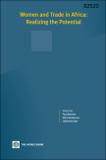
Publications & Research :: Working Paper
Women and Trade in Africa : Realizing the Potential
Attachments [ 2 ]
More Details
Regional trade in Africa can play a vital role in diversifying economies and reducing dependence on the export of a few mineral products, in delivering food and energy security, in generating jobs for the increasing numbers of young people, and in alleviating poverty and promoting a shared prosperity. Women play a key role in trade in Africa and will be essential to Africa's success in exploiting its trade potential. In many countries in Africa, the majority of small farmers are women, and they produce crops such as maize, cassava, cotton, and rice that have enormous potential for increased trade between African countries and with the global market. Women are also involved in providing services across borders, such as education, health, and professional services, including accountancy and legal services. Hundreds of thousands of women cross borders in Africa every day to deliver goods from areas where they are relatively cheap to areas in which they are in shorter supply. Yet, policy makers typically overlook women's contribution to trade and the challenges they face. This volume brings together a series of chapters that look at the ways that women participate in trade in Africa, the constraints they face, and the impact of those constraints. It seeks to extend the rather small amount of analytical work that has been devoted to this issue and to encourage researchers, especially in Africa, to look more carefully at the specific challenges women face. The chapters look at the conditions and challenges faced by three broad groups: informal cross border traders; women who participate in the production of traded goods and services, ranging from rural farmers of cotton to professional activities such as legal and accountancy services; and women entrepreneurs with dominant ownership of exporting companies. The book highlights the importance of identifying and removing the conditions that prevent women from exploiting the full potential of trading activities. This report is organized as follows: chapter one gives introduction; chapter two presents barriers, risks, and productive potential for small-scale traders in the Great lakes region; chapter three focuses on unshackling women traders: cross-border trade of Eru from Cameroon to Nigeria; chapter four focuses on women cross-border traders, challenges, and behavior change communications; chapter five gives the gender dimension of Uganda's cotton sector; chapter six focuses on services trade and gender; chapter seven focuses on gender in the tourism industry: the case of Kenya; chapter eight presents shape up and ship out?: gender constraints to growth and exporting in South Africa; and chapter nine presents trade and gender in Tanzania: what matters-participation or outcomes?.
Comments
(Leave your comments here about this item.)